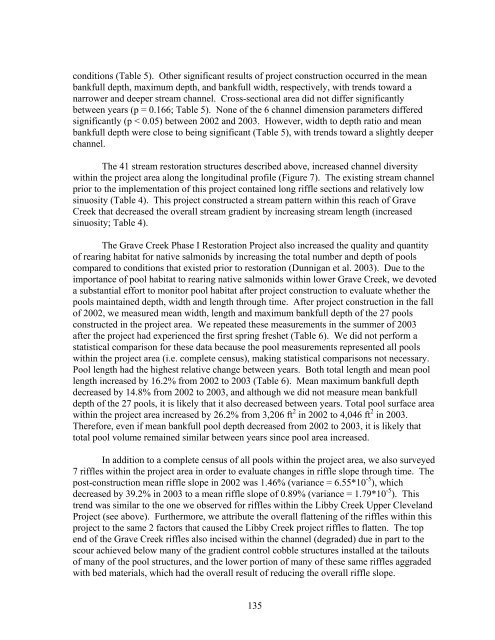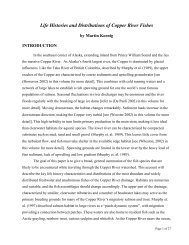Mitigation for the Construction and Operation of Libby Dam
Mitigation for the Construction and Operation of Libby Dam
Mitigation for the Construction and Operation of Libby Dam
Create successful ePaper yourself
Turn your PDF publications into a flip-book with our unique Google optimized e-Paper software.
conditions (Table 5). O<strong>the</strong>r significant results <strong>of</strong> project construction occurred in <strong>the</strong> mean<br />
bankfull depth, maximum depth, <strong>and</strong> bankfull width, respectively, with trends toward a<br />
narrower <strong>and</strong> deeper stream channel. Cross-sectional area did not differ significantly<br />
between years (p = 0.166; Table 5). None <strong>of</strong> <strong>the</strong> 6 channel dimension parameters differed<br />
significantly (p < 0.05) between 2002 <strong>and</strong> 2003. However, width to depth ratio <strong>and</strong> mean<br />
bankfull depth were close to being significant (Table 5), with trends toward a slightly deeper<br />
channel.<br />
The 41 stream restoration structures described above, increased channel diversity<br />
within <strong>the</strong> project area along <strong>the</strong> longitudinal pr<strong>of</strong>ile (Figure 7). The existing stream channel<br />
prior to <strong>the</strong> implementation <strong>of</strong> this project contained long riffle sections <strong>and</strong> relatively low<br />
sinuosity (Table 4). This project constructed a stream pattern within this reach <strong>of</strong> Grave<br />
Creek that decreased <strong>the</strong> overall stream gradient by increasing stream length (increased<br />
sinuosity; Table 4).<br />
The Grave Creek Phase I Restoration Project also increased <strong>the</strong> quality <strong>and</strong> quantity<br />
<strong>of</strong> rearing habitat <strong>for</strong> native salmonids by increasing <strong>the</strong> total number <strong>and</strong> depth <strong>of</strong> pools<br />
compared to conditions that existed prior to restoration (Dunnigan et al. 2003). Due to <strong>the</strong><br />
importance <strong>of</strong> pool habitat to rearing native salmonids within lower Grave Creek, we devoted<br />
a substantial ef<strong>for</strong>t to monitor pool habitat after project construction to evaluate whe<strong>the</strong>r <strong>the</strong><br />
pools maintained depth, width <strong>and</strong> length through time. After project construction in <strong>the</strong> fall<br />
<strong>of</strong> 2002, we measured mean width, length <strong>and</strong> maximum bankfull depth <strong>of</strong> <strong>the</strong> 27 pools<br />
constructed in <strong>the</strong> project area. We repeated <strong>the</strong>se measurements in <strong>the</strong> summer <strong>of</strong> 2003<br />
after <strong>the</strong> project had experienced <strong>the</strong> first spring freshet (Table 6). We did not per<strong>for</strong>m a<br />
statistical comparison <strong>for</strong> <strong>the</strong>se data because <strong>the</strong> pool measurements represented all pools<br />
within <strong>the</strong> project area (i.e. complete census), making statistical comparisons not necessary.<br />
Pool length had <strong>the</strong> highest relative change between years. Both total length <strong>and</strong> mean pool<br />
length increased by 16.2% from 2002 to 2003 (Table 6). Mean maximum bankfull depth<br />
decreased by 14.8% from 2002 to 2003, <strong>and</strong> although we did not measure mean bankfull<br />
depth <strong>of</strong> <strong>the</strong> 27 pools, it is likely that it also decreased between years. Total pool surface area<br />
within <strong>the</strong> project area increased by 26.2% from 3,206 ft 2 in 2002 to 4,046 ft 2 in 2003.<br />
There<strong>for</strong>e, even if mean bankfull pool depth decreased from 2002 to 2003, it is likely that<br />
total pool volume remained similar between years since pool area increased.<br />
In addition to a complete census <strong>of</strong> all pools within <strong>the</strong> project area, we also surveyed<br />
7 riffles within <strong>the</strong> project area in order to evaluate changes in riffle slope through time. The<br />
post-construction mean riffle slope in 2002 was 1.46% (variance = 6.55*10 -5 ), which<br />
decreased by 39.2% in 2003 to a mean riffle slope <strong>of</strong> 0.89% (variance = 1.79*10 -5 ). This<br />
trend was similar to <strong>the</strong> one we observed <strong>for</strong> riffles within <strong>the</strong> <strong>Libby</strong> Creek Upper Clevel<strong>and</strong><br />
Project (see above). Fur<strong>the</strong>rmore, we attribute <strong>the</strong> overall flattening <strong>of</strong> <strong>the</strong> riffles within this<br />
project to <strong>the</strong> same 2 factors that caused <strong>the</strong> <strong>Libby</strong> Creek project riffles to flatten. The top<br />
end <strong>of</strong> <strong>the</strong> Grave Creek riffles also incised within <strong>the</strong> channel (degraded) due in part to <strong>the</strong><br />
scour achieved below many <strong>of</strong> <strong>the</strong> gradient control cobble structures installed at <strong>the</strong> tailouts<br />
<strong>of</strong> many <strong>of</strong> <strong>the</strong> pool structures, <strong>and</strong> <strong>the</strong> lower portion <strong>of</strong> many <strong>of</strong> <strong>the</strong>se same riffles aggraded<br />
with bed materials, which had <strong>the</strong> overall result <strong>of</strong> reducing <strong>the</strong> overall riffle slope.<br />
135
















